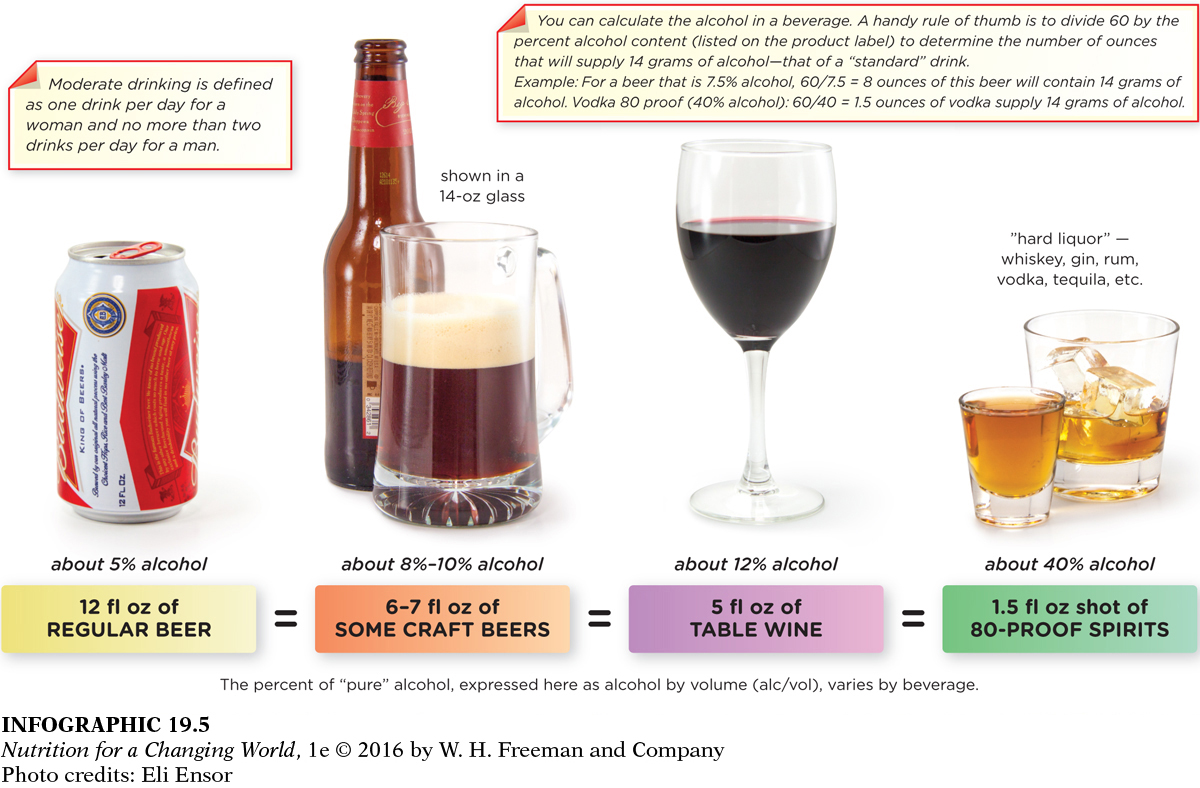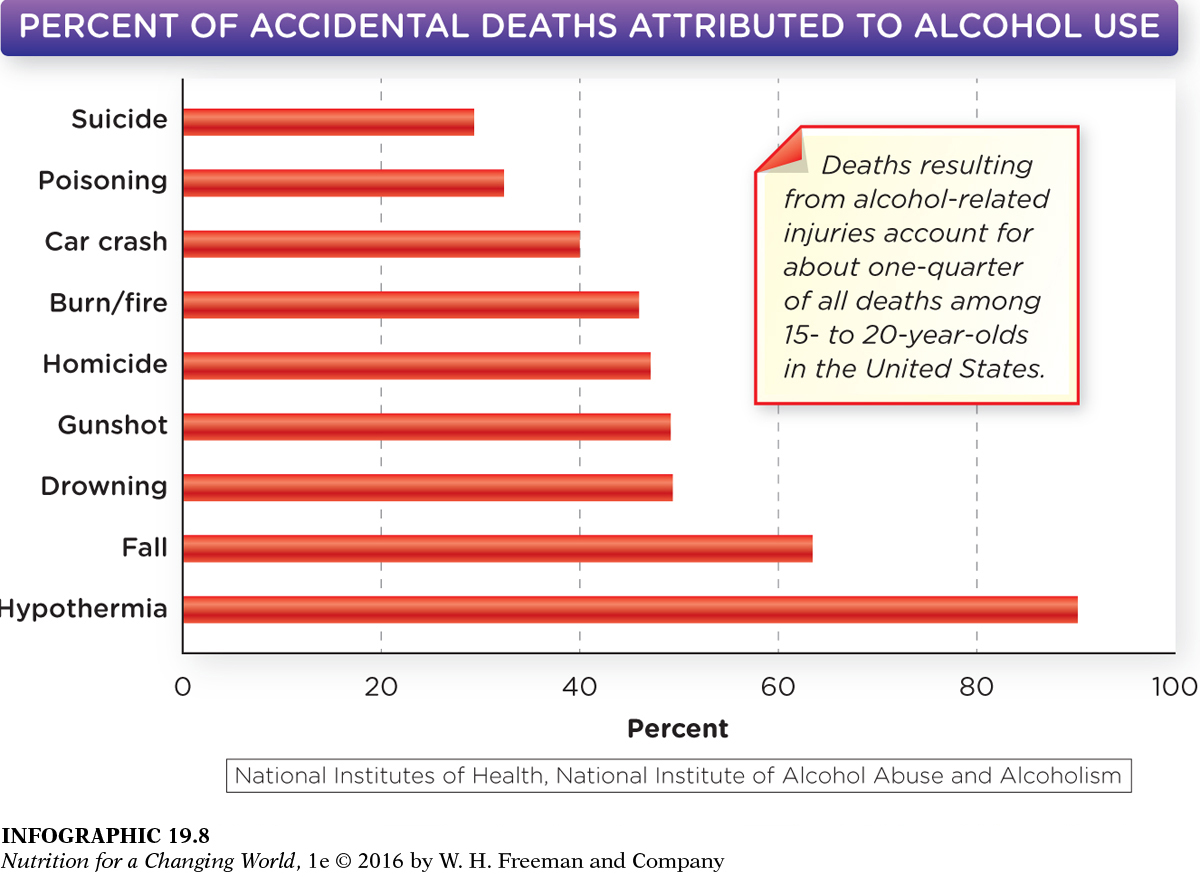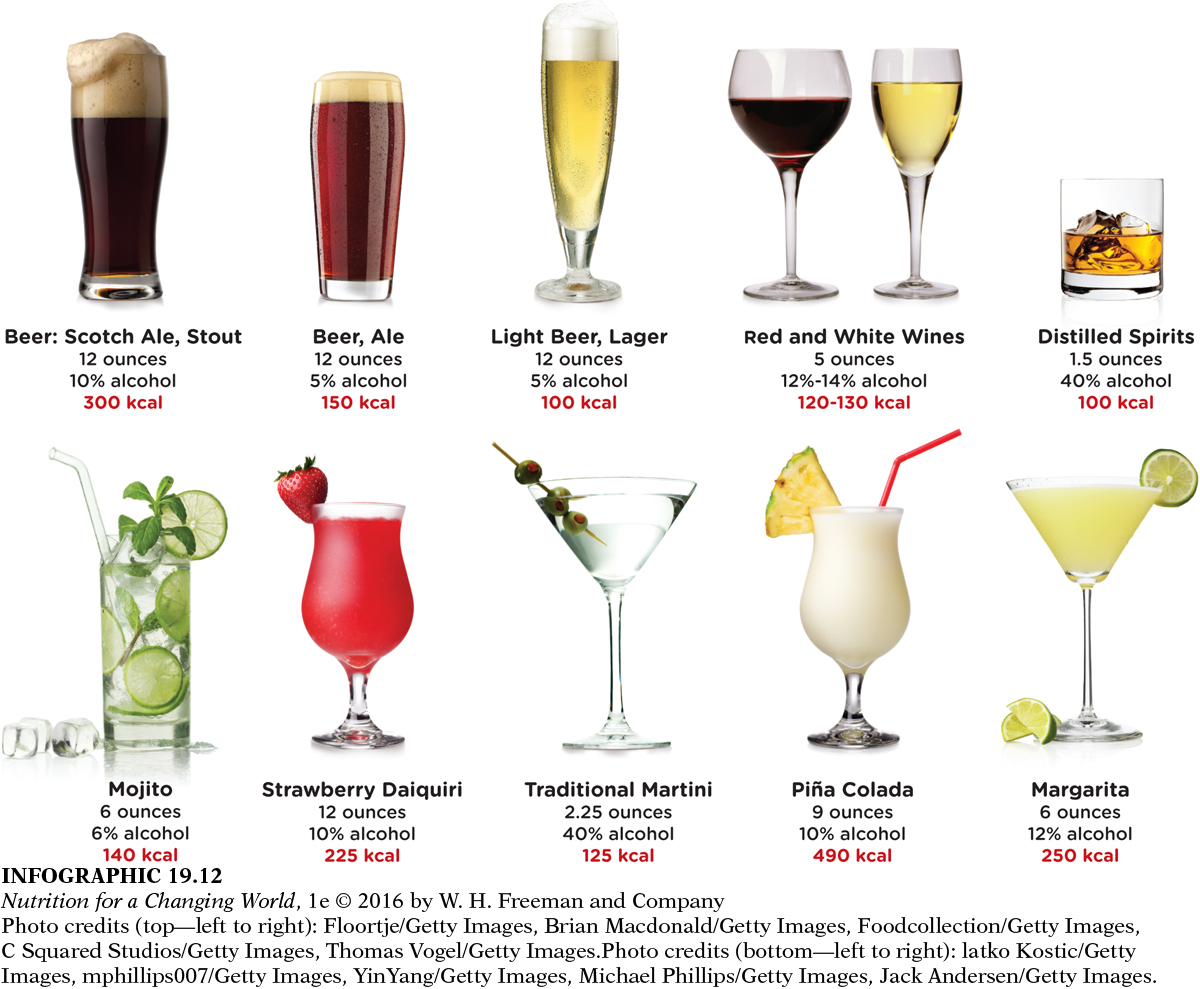ALCOHOL
ALCOHOL a potentially intoxicating ingredient found in beer, wine, and liquor; can be considered a food because it provides energy, but also has druglike effects via the central nervous system
BINGE DRINKING a pattern of alcohol consumption that brings blood alcohol concentration to 0.08% or higher, corresponding to about five or more drinks on a single occasion for men or four or more for women, generally within about two hours
HEAVY DRINKING Typically defined as consuming 15 or more standard alcohol drinks per week for men and 8 or more per week for women
Alcohol use and overuse is another issue that is often associated with the college years. People consume alcoholic drinks for many reasons—
FERMENTATION production of alcohol (and carbon dioxide) through the action of yeast on the simple sugars in grains or fruit
Alcohol is the common name for ethanol, a potentially intoxicating ingredient found in beer, wine, and liquor. Alcohol is not a nutrient, but does provide energy in the form of calories (7 kcal per gram). It has potent druglike effects, acting as a central nervous system depressant. Microscopic yeast obtain energy from simple sugars in grains or fruit via a metabolic pathway called fermentation, which produces alcohol and carbon dioxide. The carbon dioxide may be released into the air, or the carbon dioxide may be trapped in the beverage causing it to be carbonated, as when beer is brewed. Beer is made by the fermentation of grains; wine is made from grapes or other fruit. Gin, rum, vodka, and whiskey are distilled, which involves heating a fermented mixture and then cooling it to condense the alcohol content into a more concentrated liquid form.
A standard alcoholic drink is comprised of 14 grams (0.6 fluid ounces) of pure alcohol (ethanol), which can typically be found in 12 ounces of beer, 5 ounces of wine, or 1.5 ounces (a “shot”) of 80-

Question 19.4
 What type of alcoholic beverage often contains more than one standard unit of alcohol?
What type of alcoholic beverage often contains more than one standard unit of alcohol?
Mixed drinks often contain more than one standard unit of alcohol.
The metabolism of alcohol
ACETALDEHYDE a product of the first step of alcohol metabolism in the liver; a highly reactive and toxic compound that can damage cellular components
Alcohol is readily absorbed into the bloodstream through diffusion and then is transported to the body’s cells and tissues and dispersed throughout the water-

Question 19.5
 Why are individuals with high rates of ADH activity and low rates of ALDH activity at low risk of alcohol use disorder?
Why are individuals with high rates of ADH activity and low rates of ALDH activity at low risk of alcohol use disorder?
During the metabolism of alcohol, ALDH converts acetaldehyde to acetate. If, for some reason, ALDH activity is low, acetaldehyde will accumulate in the liver and cause ill effects (flushing, nausea, headache) making drinking alcohol undesirable and very unpleasant.
Factors that affect intoxication
Alcohol stays in the blood and body fluids until the liver is able to detoxify all the alcohol that has been consumed. In general, the liver can only metabolize about an ounce of alcohol per hour, regardless of how much has been consumed. Thus it is important to limit intake to prevent excessive alcohol accumulation in the blood. But many factors above and beyond the amount and rate of alcohol consumption can influence how intoxicated a person gets while drinking. These factors include the person’s sex, body weight, food intake before or during alcohol consumption, his or her use of drugs or prescription medications, and even genes.
Women, for instance, experience a more rapid rise in their blood alcohol levels than do men of the same size with similar alcohol intakes. This heightened effect is primarily a result of differences in body composition. Alcohol disperses in body water, and women—

BLOOD ALCOHOL CONCENTRATION the percentage of alcohol in blood that is used as a measure of the degree of intoxication of an individual
The concentration of alcohol in breath and urine mirrors the concentration of alcohol in the blood, so the blood alcohol concentration (BAC) of an individual can be determined by measuring the amount of alcohol in the breath. The BAC is the standard means of assessing the extent of a person’s alcohol impairment; a BAC of 0.08% is the legal limit for intoxication in the United States for drivers 21 years and older. A woman weighing 130 pounds easily exceeds the legal limit after consuming the equivalent of two alcoholic drinks. (INFOGRAPHIC 19.7)

Question 19.6
 Why do blood alcohol levels rise more quickly in women than in men of the same body weight?
Why do blood alcohol levels rise more quickly in women than in men of the same body weight?
Lower body water content in women causes blood alcohol concentrations to increase more quickly than in men of the same body weight, since alcohol disperses in water.
Potential benefits of alcohol
Alcohol consumption can provide potential health benefits. However, it is important to recognize that the evidence for the beneficial effects of alcohol is not as strong as the evidence for its harmful effects. Also, the risk-
What is “moderate” alcohol consumption?
In healthy adults, moderate alcohol consumption—
And although not depicted in the U.S. MyPlate, many national food guides from around the world include moderate alcohol consumption as a component of a healthful diet in adults. (Note that the definition of moderate consumption refers to the amount consumed on any single day and not the average over several days.) The most beneficial drinking pattern associated with a decrease in the risk of cardiovascular disease seems to be the consumption of one to two glasses of red wine immediately before or during the evening meal, as is practiced in many Mediterranean countries. However, it is not known if the benefits result from the alcohol itself, or from the social bonding or the avoidance of excess consumption that is promoted by this tradition. It is important to consider that the demonstrated benefits may also relate to the lifestyle habits and practices of people who consume moderate amounts of alcohol.
Harmful effects of alcohol
The Dietary Guidelines for Americans emphasize, however, that people should not begin drinking or drink more frequently because of these potential health benefits, because it is not possible to predict in which individuals alcohol abuse will become a problem. Also, alcohol consumption can have harmful effects on our health as well. Alcohol consumption is associated with an increased risk of some types of cancer, and excessive intake is associated with violent crime, drowning, and injuries from falls and motor vehicle crashes. Recent studies actually conclude that there is no safe level of alcohol consumption with regard to one’s risk of cancer. Even light drinking is associated with increased risk of cancers of the mouth, throat, esophagus, and breast. And the more alcohol one drinks, the greater the risk. Also, there are many confounding variables and unanswered questions as to the effect of moderate alcohol intake on overall health, chief among them the lifestyle characteristics of moderate drinkers that can contribute to reduced risk. In other words, people who drink moderately may have other healthy lifestyle habits that contribute to the reduction in disease and mortality risk. (INFOGRAPHIC 19.8)

Question 19.7
 What effects of alcohol consumption likely explain the high rates of accidental death that are associated with its use?
What effects of alcohol consumption likely explain the high rates of accidental death that are associated with its use?
Alcohol consumption causes impaired judgment, reduced reaction time, and loss of balance and motor skills. Because of these effects, alcohol consumption can lead to accidents and injuries.
Alcohol can have other adverse long-

Question 19.8
 The risk of what two categories of disease seem to be most strongly affected by excess alcohol consumption?
The risk of what two categories of disease seem to be most strongly affected by excess alcohol consumption?
Cancer and cardiovascular problems are linked to excess alcohol consumption.
Certain people should never consume any alcohol. These include children and adolescents—
FETAL ALCOHOL SPECTRUM DISORDERS a group of conditions that can occur in a person whose mother drank alcohol during her pregnancy; effects range in severity and can include physical, behavioral, and learning problems
Pregnant women, and women planning to become pregnant, should also abstain from drinking alcohol, as there is no known safe level of alcohol use during pregnancy. Several conditions, including fetal alcohol spectrum disorders (FASDs), have been linked to alcohol use during pregnancy. FASDs represent a group of conditions that can occur in a person whose mother drank alcohol during pregnancy. The effects range in severity and can include physical as well as behavioral and learning problems. Even moderate drinking (one to six alcoholic drinks per week) in pregnant women has been shown to decrease the IQ of their child when tested at eight years of age.
Individuals who plan to drive, operate machinery, or take part in other activities that require attention, skill, or coordination, as well as individuals who have medical conditions or take certain medications, should not consume alcohol. It is also wise for people with a personal or family history of alcohol use disorder, alcohol abuse, or who are unable to limit their alcohol intake to moderate levels, to abstain from alcohol use.
Among college students in particular, binge drinking, a pattern of alcohol consumption that brings the BAC to 0.08% or higher, is a big problem. This pattern of drinking usually corresponds to consuming five or more drinks on a single occasion for men or four or more drinks on a single occasion for women, generally within about two hours. As many as 17% of the U.S. population reports binge drinking, but as many as 40% of college-

Question 19.9
 How many students do you know who have in some way been negatively affected by someone else’s use of alcohol?
How many students do you know who have in some way been negatively affected by someone else’s use of alcohol?
Most students at one time or another are affected by friends or roommates who have become ill or made poor choices because of alcohol consumption.
Alcohol abuse, also common among college students, is a pattern of drinking that has negative consequences for one’s health, relationships, and academic and work performance. Signs of alcohol abuse include a failure to fulfill responsibilities, drinking despite dangers or consequences, aggressive or violent behavior while intoxicated, legal issues related to alcohol, and increasing dependency on alcohol. Frequent heavy drinking can increase alcohol tolerance by ramping up the activity of an alternate pathway of alcohol metabolism in the liver (not involving alcohol dehydrogenase). As a result, the rate at which alcohol is metabolized is increased, thereby requiring a person to drink more and more alcohol to produce the same effects. In addition, this alternative pathway produces highly reactive chemical compounds (reactive oxygen species) that cause widespread damage to tissues throughout the body. Ongoing alcohol abuse can lead to alcohol use disorder, too. Alcohol use disorder is a medical diagnosis given to individuals who have severe problems with alcohol and meet certain diagnostic criteria.
People can determine if they or their friends or loved ones have a problem with alcohol by checking for common signs and symptoms. (INFOGRAPHIC 19.11)

Question 19.10
 Do you or anyone you know display one or more of these characteristics?
Do you or anyone you know display one or more of these characteristics?
If you know anyone with multiple characteristics of alcohol use disorder, you can refer them a healthcare provider for advice or treatment.
Hangover
A common consequence of alcohol consumption is the development of a hangover as the BAC falls following an episode of excessive drinking. Although individuals exhibit large differences in hangover susceptibility, the characteristic symptoms include headache, tiredness, impaired cognitive function, thirst, dizziness, nausea, and altered mood. The underlying causes of hangover are not well-
Alcohol and nutritional considerations
There are also nutritional considerations associated with alcohol use. As alcohol contains seven calories per gram, it is a fairly dense source of energy. Yet because it lacks overall nutrient value, alcohol is considered a source of “empty calories.” (INFOGRAPHIC 19.12) The Dietary Guidelines for Americans recommend that less than 5% of total calorie intake should come from alcohol. Chronic alcohol abuse can compromise nutrition by reducing the secretion of digestive enzymes, impairing nutrient absorption and utilization, contributing to potential nutrient deficiencies. In addition, alcohol often displaces more nutrient-

College drinking can have multiple potential adverse and dangerous consequences, both short term and long term. Even if students are unwilling to consider abstaining, they should strive to drink responsibly by moderating intake, not drinking and driving, and not contributing to excessive intake by others. Awareness is the first step: Individuals should track their alcohol consumption patterns, as doing so can not only help them recognize a problem, but it can also help them set goals and come up with strategies for cutting down. Virtually all college campuses have resources and services that can support students in more responsible alcohol use. One national program that can help is the NIAAA’s Rethinking Drinking program.